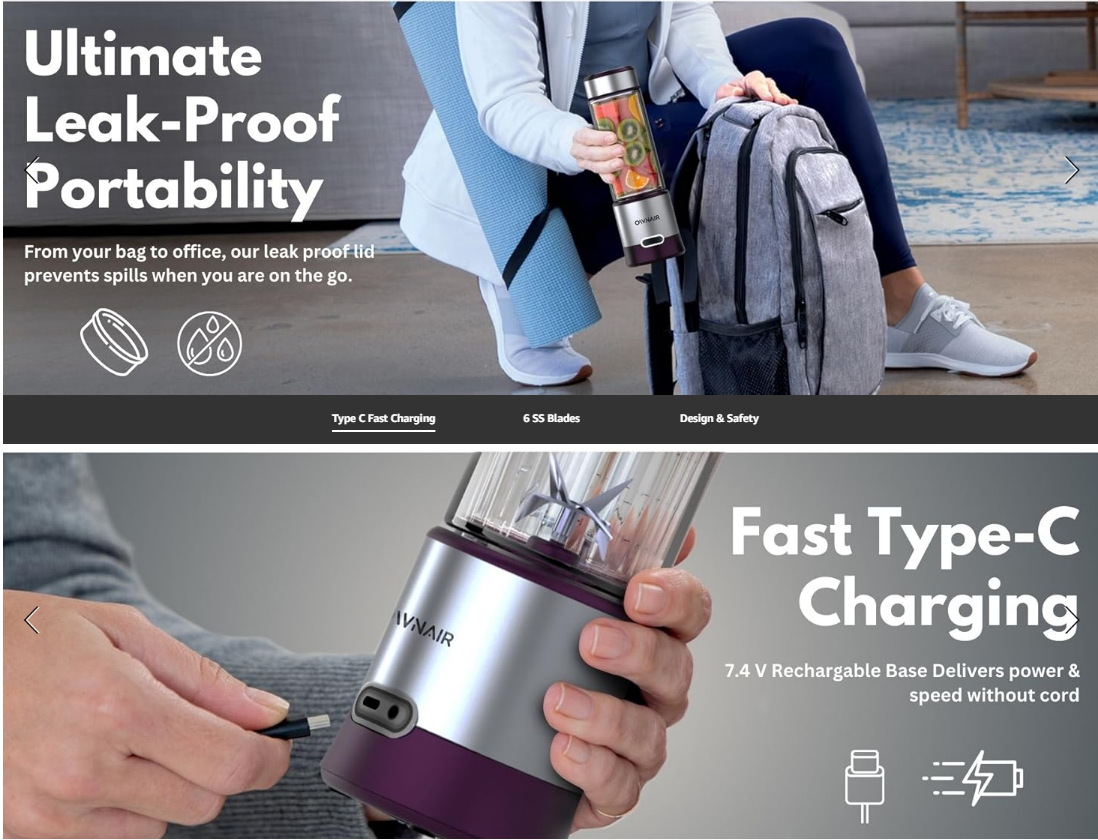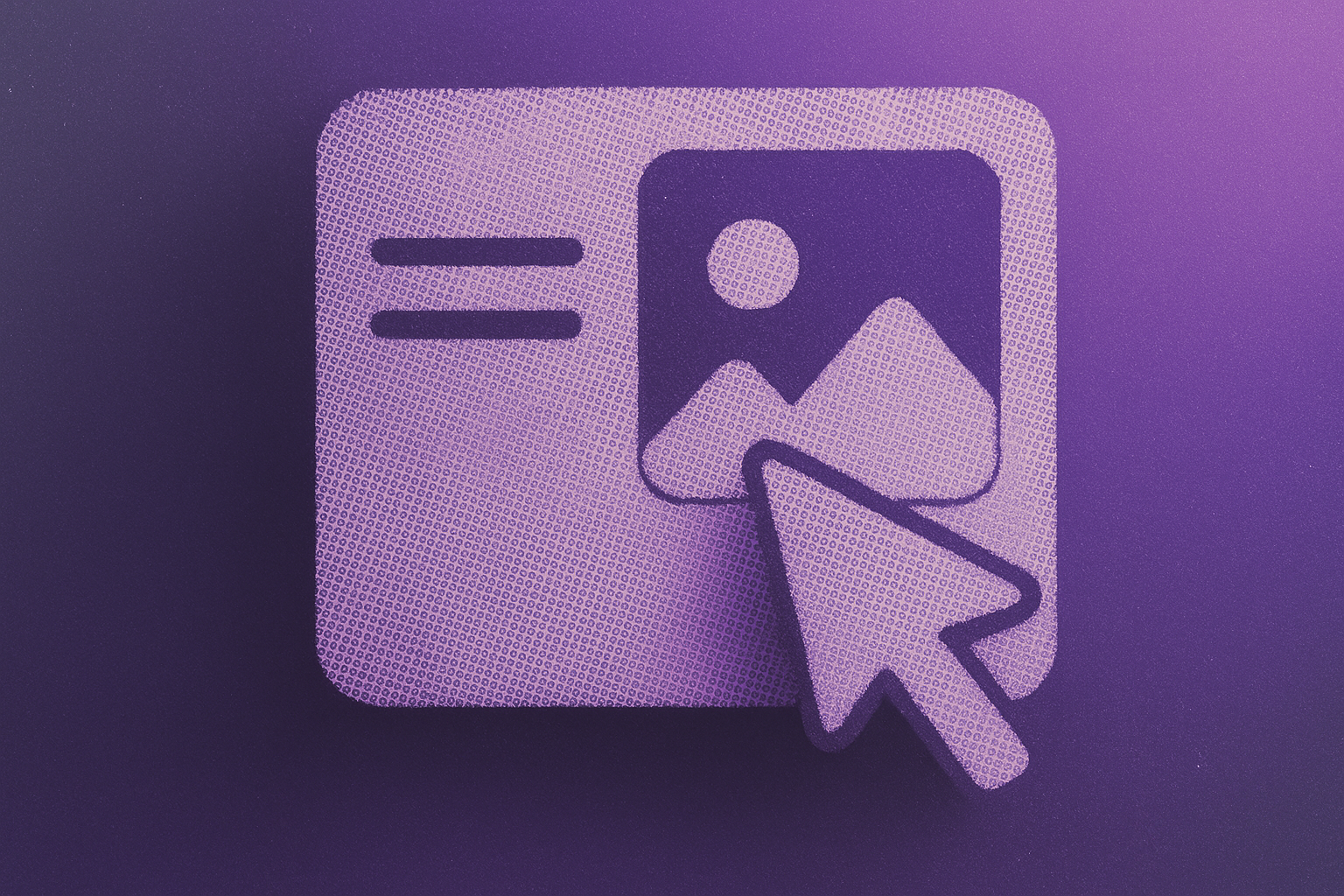Recently, while shopping for a portable blender on Amazon, I had a few questions: Does it support USB-C charging? Will it fit in my bag? Then I found a brand called OWNAIR whose product photos answered all these questions visually. One image showed the blender charging with a modern cable, another featured it tucked neatly inside a handbag, and another captured it making smoothies on the go. That’s the power of well-crafted lifestyle product images.
The picture shows exactly why I added it to my cart.

Lifestyle product images help shoppers instantly understand a product’s features and usability. However, creating such compelling lifestyle product images at scale used to mean expensive photoshoots and long editing times. Today, many brands are using AI product image generators to quickly and cost-effectively create realistic, consistent visuals.
The global market for AI image generators, which power these AI product images, was valued at USD 349.6 million in 2023 and is expected to grow to over USD 1 billion by 2030, reflecting how important these tools are becoming for brands looking to engage and convert online shoppers.
In this blog, we’ll explore the top tools transforming how brands generate AI product images to connect with their audience and boost sales.
Top 5 AI Product Image Generator Tools1. Yarnit Dreambrush
Think of Dreambrush as your creative partner that actually understands your brand. Upload a basic product photo, and watch it generate lifestyle images and short videos that feel authentically yours. This isn't just about pretty pictures—it's about maintaining your brand's visual DNA across every touchpoint.
What makes Dreambrush special:
- Brand consistency focus: Creates images that align with your visual language, not random generic scenes
- Autonomous ideation: No need to be a prompt engineering expert—the tool handles creative thinking for you
- Multiple scenario generation: One upload gives you various lifestyle contexts to choose from
- Video capabilities: Goes beyond static images to create short, engaging video content
Perfect for marketers who want their visuals to feel cohesive and on-brand, rather than like they were pulled from a stock photo library. The autonomous agents handle the heavy lifting, so you can focus on strategy instead of technical details.
2. Claid.ai
When you need to process hundreds or thousands of product images while maintaining professional quality, Claid.ai steps up to the plate. This platform combines advanced background generation with bulk processing capabilities that enterprise teams love.
Key strengths include:
- Dual generation modes: Create backgrounds from image references or text descriptions
- Bulk catalog processing: Handle large inventories efficiently with consistent results
- API integration: Seamlessly connect with existing workflows and e-commerce platforms
- Professional-grade enhancement: Maintains product details while creating realistic scene integration
Testing shows Claid.ai excels at creating realistic AI product images where products blend seamlessly into backgrounds while preserving every important detail. The custom template uploads and enterprise features make it particularly valuable for high-volume operations.
3. Adobe Firefly
If your team already lives in the Adobe ecosystem, Firefly brings intelligent image generation right into your familiar workflow. This isn't a standalone tool—it's deeply integrated with Photoshop and Illustrator, making it perfect for design teams who want to push creative boundaries.
Notable features:
- Seamless Adobe integration: Works within your existing Photoshop and Illustrator workflows
- Text-to-image generation: Describe your vision and watch it come to life
- Extensive customization: Fine-tune every aspect of your generated images
- 100+ language support: Create content for global markets
While Firefly requires more technical expertise than simpler alternatives, it rewards creative professionals with incredible flexibility and control. If you have the skills to navigate its interface, you can create truly unique lifestyle scenes.
4. Midjourney
Some brands don't just want good product photos—they want visuals that stop people mid-scroll. Midjourney has built its reputation on creating magazine-quality images that elevate products from ordinary to aspirational.
Why luxury brands love it:
- Magazine-quality aesthetics: Creates images that belong in high-end publications
- Artistic interpretation: Transforms product shots into visual art
- Premium positioning: Perfect for brands targeting luxury markets
- Creative community: Access to inspiration from other creators and artists
If your brand positioning is premium or luxury, Midjourney's artistic quality can help create lifestyle images that reflect that elevated status. These aren't just product shots—they're visual statements.
5. DALL-E 3
Built right into ChatGPT, DALL-E 3 brings a conversational approach to image creation. Instead of wrestling with complex prompts, you can literally have a conversation about what you want and refine your requests in real-time.
What sets it apart:
- Conversational interface: Discuss your vision naturally, no technical jargon required
- Context understanding: Interprets nuanced requests and complex creative briefs
- Real-time refinement: Adjust and improve images through ongoing dialogue
- Precision storytelling: Create specific scenarios with particular details and settings
This accessibility makes DALL-E 3 particularly user-friendly for those who aren't familiar with technical prompt writing. You can be very specific about the story you want your product images to tell.
How to Choose the Right AI Product ImageTool
Selecting the perfect AI tool for your AI product images depends on several key considerations:
Primary Use Case
Are you creating images for e-commerce listings, social media campaigns, or premium marketing materials? Different tools excel in different contexts. Yarnit Dreambrush is perfect for brand-consistent marketing content, product images suitable for e-commerce platforms like Shopify, Amazon, etc.
Volume Needs
Consider how many images you need to process. Tools like Claid.ai and Pebblely offer bulk processing capabilities that can handle thousands of images, while others are better suited for smaller, more curated batches.
Image Quality and Style Match
Different tools have different aesthetic strengths. Midjourney creates artistic, aspirational images, while others focus on realistic, commercial photography. Choose based on your brand's visual style requirements.
Integration Capabilities
If you're working within existing workflows, consider how well the tool integrates with your current systems. Adobe Firefly works seamlessly with Adobe products, while tools with API access can integrate with your e-commerce platforms.
Budget Considerations
Pricing models vary significantly. Some tools offer subscription-based pricing, others charge per image. Consider your volume needs and calculate the long-term costs based on your usage patterns.
Scalability and Real-World Performance
Test how tools perform under your actual working conditions. Some excel with certain product types or styles. Most platforms offer free trials – use them to evaluate performance with your specific products.
Other Tips to Best Utilize These Tools
Master the Art of Correct Prompting
The quality of your AI product images heavily depends on how well you describe what you want. Be specific about lighting conditions, backgrounds, mood, and context. Instead of "product on table," try "product on rustic wooden table with soft morning light and coffee shop atmosphere."
Want to prompt templates to master AI product images for your business? Check out our blog here.
Ensure Realistic Images with Human Elements
Including human elements or realistic contexts helps viewers imagine themselves using your product. Show your product being held, worn, or used in natural settings. This creates emotional connections that pure product shots can't achieve.
Test Across Multiple Tools
Don't limit yourself to one tool. Different AI platforms excel at different types of images. You might use one tool for bulk processing and another for hero images that need extra creativity.
Maintain Brand Consistency
Create style guides for your AI-product images. Document successful prompts, color schemes, and compositional elements that work well for your brand. This ensures consistency across all your visual content.
Combine AI with Human Creativity
Use AI as a starting point, not the final destination. The best results often come from using AI to generate base images and then adding human touches for refinement and brand alignment.
Boosting E-commerce Conversions With AI Product Images
These tools aren't just cutting costs – they're opening up creative possibilities that were previously impossible or prohibitively expensive. From bulk processing of AI product images to creating magazine-quality lifestyle shots, AI is democratizing professional-grade visual content creation.
The key is finding the right tool that matches your specific needs, whether that's volume processing, creative flexibility, or seamless integration with existing workflows. Each of the tools we've explored brings unique strengths to the table.
For brands looking to go beyond image generation, platforms like Yarnit offer a more connected approach to e-commerce content creation. Apart from Dreambrush, which simplifies lifestyle image production, Yarnit brings together a suite of agentic applications designed for the entire retail journey — from catalogue management to smart campaign execution.It’s a comprehensive ecosystem built to help teams manage visuals, content, and marketing efforts in one place, ensuring brand consistency without slowing down creative momentum.
Yarnit’s ability to re-edit generated images and set presets for different use cases, whether for homepage features or individual product pages, makes it especially useful for marketers seeking both agility and alignment.
As technology evolves, these AI product image generation tools will only grow more capable — blending creativity with scale to help brands tell their stories better, faster, and smarter. The real question isn’t whether to use them, but how to make them work best for your brand.
FAQs
Q1. What are AI product images and how do they help in eCommerce?
A. AI product images are visuals created or enhanced using artificial intelligence, enabling brands to generate realistic lifestyle images quickly. These images help shoppers visualize how products fit into real life, boosting confidence and conversion rates.
Q2. Why are lifestyle product images important for online shopping?
A. Lifestyle product images show products in real-world settings, helping customers understand usability, scale, and benefits better than plain product shots. They create an emotional connection, improving engagement and sales.
Q3. Can AI product image generators replace traditional photoshoots?
A. AI tools significantly speed up and reduce the cost of generating product visuals, but they often complement professional photography, especially for high-end or complex campaigns.
Q4. How do I choose the right AI tool for generating lifestyle product images?
A. Consider your primary use case (e.g., eCommerce listings, social ads), volume needs, desired image style, platform integration, and budget. Tools like Yarnit excel in brand consistency, while Claid.ai is strong for bulk processing.
Q5. Are AI product images customizable for different marketing channels?
A. Yes. Many AI platforms let you create presets and different versions tailored for social media, websites, or ads while maintaining brand uniformity.









